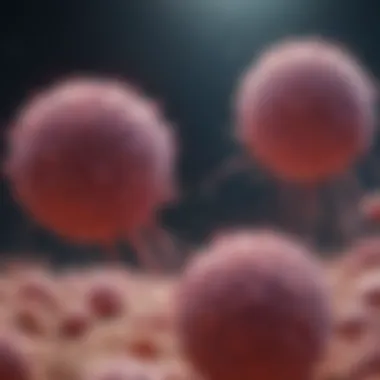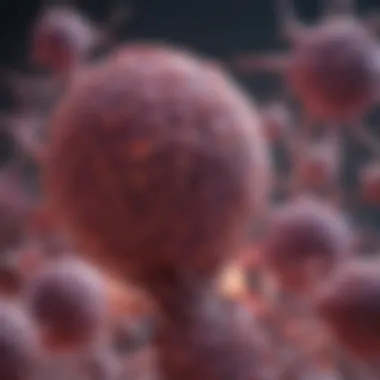The TSC1 Gene's Role in Cancer Development


Intro
The TSC1 gene plays a pivotal role in the realm of cancer biology, exhibiting intricate connections with tumor development and progression. To understand its implications, one must appreciate the gene’s various functions, particularly in cell growth regulation and tumor suppression. Not only does TSC1 serve vital roles in cellular processes, but its mutations can lead to a cascade of complications, fostering an environment conducive to cancerous growths. This article delves into the multifaceted relationship between the TSC1 gene and cancer, dissecting various dimensions from its function to therapeutic prospects.
Research Overview
Summary of Key Findings
Recent studies underscore the significance of the TSC1 gene in thwarting tumor development. Findings suggest that when TSC1 is functioning normally, it acts as a break on cell proliferation and growth. In instances where mutations disrupt this function, as seen in certain cancer types, the lack of tumor suppression can spur unchecked cell division.
- Tumor Suppression: The TSC1 gene forms part of a complex that inhibits the mTOR pathways, crucial for cell growth.
- Mutation Implications: Mutations of TSC1 can engender several malignancies, particularly i.e. brain, kidney, and lung tumors
- Therapeutic Potential: Targeting the pathways associated with TSC1 presents an avenue for intervention in cancer treatment.
Background and Context
Cancer development is a multifactorial process, influenced by genetic, environmental, and lifestyle factors. The role of certain genes, including TSC1, is essential in understanding cancer pathogenesis. TSC1 works closely with its partner gene, TSC2, to regulate cell size and growth, acting as a guardian against the relentless cell proliferation characteristic of cancer.
Moreover, various cancers have been linked to TSC1 mutations. These mutations may alter the TSC1 protein, diminishing its ability to control pivotal growth pathways. Research suggests that individuals with TSC1 mutations may manifest not only tumors but also other health issues.
"The exploration of TSC1 gene mutations opens a new chapter in personalized medicine, as targeted therapies may significantly impact patient outcomes."
Methodology
Experimental Design
To provide comprehensive insights into the TSC1 gene's roles, studies generally employ a mix of in vitro and in vivo approaches. These methods help scrutinize the gene's performance under various conditions and in different cell lines. Furthermore, xenograft models have proven effective in evaluating tumorigenesis resulting from TSC1 mutations.
Data Collection Techniques
Data is typically collected through a combination of genomic sequencing, bioinformatics analysis, and molecular assays. High-throughput sequencing offers valuable insights into specific mutations present in the TSC1 gene across various cancer types. Additionally, functional assays assess how these mutations affect cellular processes categorized under various conditions.
In summary, the TSC1 gene’s involvement in cancer is profound, shaping both basic research and clinical applications. The accumulating evidence of its importance paints a compelling picture, urging continued exploration.
Prelims to the TSC1 Gene
The TSC1 gene plays a pivotal role in understanding how certain cellular mechanisms can influence cancer development. This gene is part of a larger complex that functions primarily as a tumor suppressor, making it fundamental in studying tumorigenesis. Recognizing the TSC1 gene's significance provides insights into tumor biology and opens potential avenues for therapeutic interventions. By delving into the intricacies of its role, we can appreciate how genetic variations impact normal cellular processes and contribute to malignancy.
Overview of TSC1 Function
TSC1, known as the tuberous sclerosis complex 1 gene, encodes a protein that works alongside TSC2 to form a complex crucial for regulating cell growth and metabolism. Within this framework, TSC1 acts as a GTPase-activating protein, effectively keeping the mammalian target of rapamycin complex 1 (mTORC1) pathway in check. When functioning properly, this complex inhibits mTORC1, which in turn regulates cell proliferation, survival, and metabolism, ensuring that they occur according to the body's needs. Imbalances in this regulation due to TSC1 mutations can lead to uncontrolled cell growth.
In simpler terms, think of TSC1 as a traffic light at a busy intersection. When it's green, everything flows smoothly and safely; when it turns red due to mutations or dysregulation, chaos can ensue, leading to cancerous growth.
Importance in Tumor Suppression
The contributions of the TSC1 gene to tumor suppression cannot be overstated. Tumor suppression is a critical defense mechanism against cancer. When TSC1 functions correctly, it hinders the mTORC1 pathway, signaling cells to stop dividing inappropriately. This action prevents tumors from forming in various tissues, essentially acting as the brakes on cellular proliferation.
Without these brakes, cells can grow unchecked. The connection between TSC1 and cancer becomes clearer when you consider that aberrations in this gene can lead to several types of tumors, further highlighting its role as a guardian against cancer.
"The TSC1 gene acts as a sentinel within the cell, ensuring that growth signals do not spiral out of control."
A failure in TSC1 can result in conditions like tuberous sclerosis, characterized by benign tumors in multiple organs, such as the brain and kidneys, which shows that malignancy risks are heightened when tumor suppressive functions are compromised. By exploring TSC1 and its functions, researchers and clinicians can improve understanding of cancer mechanisms and, ultimately, enhance treatment strategies for those who suffer from cancers where TSC1 mutations play a role.
Genetic Basis of TSC1
Understanding the genetic basis of the TSC1 gene is crucial to the discussion of its role in tumor development and human health. The TSC1 gene, alongside TSC2, encodes proteins that play a pivotal role in the regulation of cellular growth and fertility. Delving into this subject helps illuminate the genetic architecture behind TSC1 and how alterations can set a cascade of tumorigenic events into motion. Since cancer often stems from disruptions in normal cellular functions, comprehending the genetics of TSC1 becomes not just an academic endeavor but also a key to potential therapeutic avenues.
Location and Structure
The TSC1 gene is located on chromosome 9 at the band 34. It spans approximately 50 kb and comprises multiple exons that are integral to its function. The gene product, hamartin, plays a vital role in the tumor-suppressive pathways by regulating mTOR signaling, impacting processes like cell proliferation and differentiation.
In terms of structure, the TSC1 protein interacts with the TSC2 protein, forming a complex that is critical for proper cellular function. This interaction is a fine example of how protein structures underpin gene function, and any disruption can unravel significant biological pathways.
Mutations and Variants
Types of Mutations
Mutations in the TSC1 gene can vary widely, with missense mutations and frameshift mutations making up a notable portion of the alterations seen in cancer patients. Missense mutations, where a single nucleotide change results in a different amino acid in the protein, can affect the stability and function of hamartin. On the other hand, frameshift mutations often result in a premature stop codon, yielding nonfunctional versions of the protein altogether.


These mutations are significant for a few reasons. Firstly, the diversity of mutation types sheds light on the gene’s vulnerability, showing how even minor alterations in the genetic code can drastically change protein function and, consequently, cellular behavior. Secondly, understanding these mutations can help pinpoint patients at higher risk for certain cancers, guiding clinical management and preventative measures.
The unique feature of the TSC1 mutations is that they often lead to a loss of heterozygosity in tumor tissues, meaning that one of the gene's copies is lost, which heightens tumor risk.
Impact on Protein Function
The impact of mutations on protein function is profound. Altered hamartin due to mutations can compromise the protein's ability to bind to TSC2, resulting in the inadequate regulation of the mTOR pathway. This loss of control can prompt uncontrolled cell growth and division, a hallmark of cancer.
Moreover, the severity of the mutation correlates with the degree of protein dysfunction. If a mutation disrupts the binding site or causes misfolding, the downstream effects can lead to significant pathological conditions, including various tumors. The advantage of exploring these consequences lies in developing targeted therapies that can restore or mimic the function of the normal protein. This route may hold promise for personalizing treatment based on the specific mutations present in an individual’s cancer.
In summary, the genetic basis of TSC1 provides a window into understanding cancer’s complex playing field. Its location, structural features, various mutation types, and functional impacts are instrumental in shedding light on the tumorigenic processes governed by this critical gene. The intricacies of how TSC1 mutations foster cancer development exemplify why ongoing research into target-specific therapies is both relevant and necessary.
Pathways Influenced by TSC1
The TSC1 gene plays a crucial part in regulating several cellular pathways, serving as a significant player in the laboratory of cancer biology. Understanding these pathways is paramount because it not only provides insight into the mechanisms of tumorigenesis but can also unveil potential therapeutic targets. TSC1's influence extends primarily through its involvement in the mTOR signaling pathway and intersects with other critical pathways such as the PI3K/Akt and AMPK pathways.
Exploring these pathways, we glean how TSC1 mutations can cascade into dysregulation and, ultimately, to cancer.
mTOR Signaling Pathway
Role of mTOR in Cell Growth
mTOR is often portrayed as the conductor in the orchestra of cell growth and metabolism. It helps cells respond to nutritional cues, regulating protein synthesis and cell division. The role of mTOR in promoting cell growth is particularly telling when discussing TSC1's contributions. When TSC1 functions correctly, it inhibits mTOR activity, essentially placing the brakes on this growth process.
Key characteristic: mTOR functions as a nutrient and energy sensor, weighing cellular conditions before permitting growth. This selective growth process becomes beneficial in tightly regulating cellular proliferation and differentiation.
Unique to this pathway is its dual role in growth promotion and inhibition. On one side, adequate mTOR activity ensures that only healthy cells thrive, while its inhibition by TSC1 can prevent tumor progression by modulating cell growth. Still, overactive mTOR signaling due to TSC1 mutation leads to unchecked cellular expansion and tumor development.
Feedback Mechanisms
While mTOR is primarily about growth, feedback mechanisms play a vital role in homeostasis. Feedback pathways ensure that, when nutrient levels drop or stress signals increase, cell growth is prudently dialed back. The relationship between TSC1 and these feedback mechanisms is delicate; TSC1 oversees mTOR activity, which can lead to alterations in various feedback loops essential for maintaining cellular balance.
Key characteristic: Feedback mechanisms act as internal watchdogs, crucial for steadying the balance of cell growth and metabolic activity. They can also become dysfunctional in cancers associated with TSC1 mutations, exacerbating harmful growth signals.
A unique feature here lies in the complexity of cellular signaling. When feedback mechanisms fail, cells might undergo over-proliferation. Thus, understanding these interactions elucidates why TSC1 mutations can significantly precipitate oncogenesis.
Interaction with Other Pathways
PI3K/Akt Pathway
The PI3K/Akt pathway is integral in transmitting signals that promote cell growth, proliferation, and survival. TSC1 interacts significantly with this pathway, providing an added layer of regulation. When TSC1 is absent or mutated, the PI3K/Akt pathway becomes hyperactive—allowing for uncontrolled cell growth and survival, quintessential indicators of cancer.
Key characteristic: This pathway serves as a conduit for growth factors, enabling cells to react swiftly to external signals toward growth and survival when functioning appropriately.
A unique aspect of the PI3K/Akt pathway is its interconnectedness with various hormonal signals, including insulin. This cross-talk means alterations can have far-reaching impacts across multiple cellular functions, making it a focus for therapeutic intervention when TSC1 aberrations are present.
AMPK Signaling
The AMP-activated protein kinase (AMPK) pathway is known for its role in energy homeostasis. TSC1 influences AMPK signaling, which functions as a hard-stop sign for unregulated growth when energy levels are low. In cancer cells, aberrations in the TSC1 gene can lead to AMPK signaling being impaired, which further exacerbates growth signals from mTOR and other pathways.
Key characteristic: AMPK acts as a cellular energy sensor, promoting catabolic pathways that generate ATP while inhibiting anabolic processes. Its activation is critical, particularly in low-energy environments.
What sets AMPK apart is its capability to regulate both cellular metabolism and growth. When TSC1 mutations impair AMPK signaling, it leads to an unrestrained energy-consuming growth state, ultimately favoring cancerous behaviors.
In summary, the pathways influenced by TSC1, including mTOR, PI3K/Akt, and AMPK, offer a complete picture of how TSC1 operates within cellular homeostasis. Understanding these relationships not only helps clarify cancer mechanisms but also serves as a roadmap for potential therapeutic strategies.
TSC1 and Cancer Development
The TSC1 gene plays a significant role in the development of cancer, acting as a crucial checkpoint in cellular processes. When this gene is altered or mutated, it can lead to unchecked cell growth and tumor formation. This section dives into the types of cancers related to TSC1 mutations and the mechanisms by which these mutations contribute to tumorigenesis.
Types of Cancers Associated with TSC1 Mutations
Brain Tumors
Brain tumors connected with TSC1 mutations present a notable aspect of cancer development. Specifically, these tumors can often arise in individuals with Tuberous Sclerosis, a genetic disorder linked to TSC1 and TSC2 gene mutations. One key characteristic of brain tumors in this context is the presence of subependymal giant cell astrocytomas (SEGAs), which are slow-growing but can obstruct cerebrospinal fluid pathways. These tumors are a beneficial choice for discussion here because they exemplify the direct impact of TSC1 mutations on brain health.
One unique feature of brain tumors associated with TSC1 is their potential for surgical intervention. Surgeons can often remove SEGAs, offering relief from symptoms. However, the disadvantages include the high potential for recurrence, which emphasizes the resilience of cells when TSC1 functionality is reduced.


Renal Tumors
TSC1 mutations also significantly influence the pathway to renal tumors, particularly renal angiomyolipoma. A key characteristic of these tumors is their benign nature, but they can lead to severe complications, such as hemorrhage, if they grow large enough. This is a popular choice for highlighting TSC1's role in cancer since it underscores not only tumor formation but also the challenges tied to managing benign lesions.
The unique feature of renal tumors in TSC1 context is that they often remain asymptomatic until substantial size is reached, allowing them to evade early diagnosis. Despite this, the advantages of understanding these tumors lie in identifying patterns for better monitoring, potentially leading to timely interventions.
Others
Beyond brain and renal tumors, other types associated with TSC1 mutations include lymphangioleiomyomatosis (LAM), particularly affecting women of childbearing age. The specific aspect of LAM is its infiltration of lung tissues, leading to significant respiratory challenges and reduced quality of life. This highlights a beneficial aspect because it showcases how TSC1 mutations can influence non-cancerous but serious health issues.
A unique feature of LAM is the connection with other conditions such as tuberous sclerosis complex itself, creating a more complex health picture. This adds disadvantages—the need for a multifaceted treatment approach, as LAM management often necessitates more than just tumor-focused care, leading to the involvement of various medical specialties.
Mechanisms of Tumorigenesis
Cell Proliferation
The process of cell proliferation linked to TSC1 mutations is pivotal in understanding tumor development. A specific aspect to highlight is that TSC1 plays a role in inhibiting mTOR signaling, which, if left unchecked, can lead to excessive cell division. The key characteristic of this in the context of cancer is the way in which cells gain the ability to bypass normal growth controls. This makes the study of cell proliferation crucial in the overall narrative of TSC1's role in cancer.
One unique feature of cell proliferation related to TSC1 is the interplay with environmental factors that can also provoke growth signals. This means that tumorigenesis is not solely due to genetic mutations but also influenced by external stimuli, making the understanding of cancer an intricate dance of signals.
Apoptosis Resistance
Another important mechanism associated with the TSC1 gene in cancer development is apoptosis resistance. TSC1 mutations can lead to an inability of cells to undergo programmed cell death, allowing damaged cells to survive and proliferate. The specific aspect here is that not all cells will respond equally to stress signals, leading to a heterogeneous tumor population.
A key characteristic of apoptosis resistance is how it often coexists with other mutations and pathways, leading to survival advantages for malignant cells. This becomes a beneficial aspect for researchers because understanding these pathways may reveal new therapeutic targets.
The unique feature of apoptosis resistance in relation to TSC1 makes it imperative in exploring how therapies can be designed to encourage cell death in tumor cells. While the disadvantages include the increasing complexity of cancer treatment, it also drives innovation in developing therapies that can effectively push cancer cells towards death instead of evasion.
Clinical Implications of TSC1 Aberrations
The investigation into TSC1 aberrations opens up a myriad of clinical implications, especially in the realm of cancer diagnostics and treatment strategies. Understanding how TSC1 mutations impact cellular behavior can inform the development of better diagnostic tools and precision medicine approaches. The abnormalities in this gene act as a powerful marker, guiding clinicians in making informed decisions regarding the management of cancers associated with TSC1 disruptions.
Diagnostic Applications
Genetic Testing
Genetic testing serves as a cornerstone in identifying TSC1 mutations, with its role not only pivotal but also transformative in the landscape of cancer diagnosis. By using targeted sequencing to detect mutations, healthcare providers gain significant insight into an individual's risk for developing specific cancers. The high sensitivity of genetic tests makes them invaluable for early diagnosis. The primary allure of genetic testing lies in its ability to guide clinical decisions.
However, it's important to note that while genetic testing provides a wealth of information, it also presents challenges. These include potential false positives or false negatives, which can complicate the clinical picture. For individuals who carry mutations but do not exhibit symptoms, the implications can be profound, raising questions of anxiety and the need for ongoing surveillance.
Biomarkers
Biomarkers are crucial indicators in the realm of cancer; they help in understanding disease progression and response to therapy. In the case of TSC1, specific biomarkers can be pivotal in diagnosing and predicting outcomes. Their detective nature allows for the real-time assessment of tumor biology. The uniqueness of TSC1-related biomarkers is that they reflect the underlying genetic alterations, offering a window into the molecular profile of the tumor.
The primary advantage of biomarkers is their ability to guide therapeutic choices, enabling a tailored approach to treatment. However, one must tread carefully, as not all biomarkers exhibit reliability, and their interpretation can vary significantly across different cancers. Thus, while they stand as a powerful tool, their applicability needs careful consideration in clinical settings.
Prognostic Value
Survival Outcomes
Understanding survival outcomes associated with TSC1 aberrations is pivotal for guiding treatment and counseling patients. Anomalies in the TSC1 gene can significantly affect prognosis, as many studies indicate a correlation between TSC1 mutations and aggressive tumor behavior. The key characteristic worth highlighting is the underlying relationship between TSC1 status and patient outcomes. Clinicians can utilize this information not just to predict survival rates but also to tailor follow-up care and emphasize monitoring strategies.
Survival outcomes can vary dramatically, highlighting the need for personalized management plans. However, these metrics must be interpreted in light of other clinical factors, such as adjunct mutations and overall health, which can be a mixed bag for the treating physician.
Tumor Response to Treatment
Additionally, analyzing tumor response to treatment in the context of TSC1 mutations yields indispensable insights. Certain therapies, especially targeted therapies focused on the mTOR pathway, have shown variable efficacy in tumors harboring TSC1 mutations. This dynamic interaction means that treatment regimens can be fine-tuned based on TSC1 status, making it a valuable piece of the oncology puzzle.
Understanding the response to therapy provides a dual-purpose benefit; it not only informs current treatment strategies but also steers future drug development. The challenge lies in the heterogeneity of tumors, where nuances in TSC1 mutations can lead to different responses in otherwise similar cancers. This variability necessitates a comprehensive understanding of each patient’s genetic landscape to optimize therapeutic outcomes.
The presence of TSC1 aberrations not only informs diagnostics but also significantly shapes treatment strategies and expected outcomes in patients, highlighting its integral role in cancer management.
Therapeutic Targeting of TSC1
The exploration of therapeutic targeting of the TSC1 gene is a crucial aspect in understanding its role in cancer pathogenesis. TSC1, responsible for regulating cellular growth and metabolism, often finds itself compromised in various malignancies. This vulnerability opens doors for therapeutic strategies aimed at restoring function or counteracting the consequences of TSC1 mutations. The significance of this targeting is underscored by the urgent need for effective treatments in cancers where TSC1 plays a pivotal role. Let's delve into what existing treatments are available and what promising strategies are on the horizon to harness this gene's therapeutic potential.
Existing Treatments


Current therapeutic options predominantly focus on addressing the consequences of TSC1 mutations rather than the mutations themselves. Many cancer patients, especially those with renal tumors linked to TSC1 aberrations, are being treated with targeted therapies that exploit the pathways downstream of TSC1. For instance, Everolimus is a well-known mTOR inhibitor that has shown effectiveness in metastatic renal cell carcinoma. By impeding the mTOR pathway, Everolimus indirectly compensates for the lack of TSC1 function, thereby inhibiting cell proliferation and promoting apoptosis in tumor cells.
One must consider, however, that while existing treatments can manage disease symptoms or slow progression, they may not be a panacea. Side effects and the development of resistance are common observations, raising ongoing questions about the sustainability of these treatments in long-term care.
Emerging Therapeutic Strategies
As researchers dig deeper into the complexities of the TSC1 gene and its impact on cancer biology, new strategies are emerging that promise to enhance treatment efficacy.
mTOR Inhibitors
When discussing mTOR inhibitors, one cannot overlook their role in the landscape of TSC1-targeted therapy. These agents are significant because they specifically target the mTOR pathway, which is often dysregulated in tumors lacking functional TSC1.
The key characteristic of mTOR inhibitors is their ability to selectively halt the growth of cancer cells. This selectivity stems from their focus on the mTOR signaling cascade, which is critical for cell proliferation, survival, and metabolism. What makes them a popular choice is the demonstrable reduction in tumor size and improved patient outcomes observed in clinical trials.
A unique feature of mTOR inhibitors is their dual role: not only do they curb tumor growth, but they can also reshape the metabolic landscape of cancer cells. However, a consideration worth mentioning is the potential for serious side effects. These can include stomatitis, rash, and increased risk of infections—limitations that clinicians must weigh against the benefits in treatment planning.
Combination Therapies
Combination therapies are gaining traction, especially in the wake of evidence suggesting that monotherapies might not suffice in all cases. The turning tide towards combination approaches stems from their ability to target multiple pathways simultaneously, thus potentially overcoming the limitations of single-agent treatments.
The key characteristic of combination therapies lies in their synergistic potential. By integrating mTOR inhibitors with other agents—such as immunotherapy or targeted therapies focusing on the PI3K/Akt pathway—clinicians can optimize the chances of durable responses in patients with TSC1-related cancers. This multifaceted strategy is a beneficial choice, particularly in patients who exhibit resistance to conventional treatments.
A distinct feature of combination therapies is their adaptability; treatment plans can be refined based on individual patient profiles and tumor characteristics, creating personalized care strategies. However, this approach may also come with increased complexity in terms of potential drug interactions and the cumulative toxicity that may arise from multiple agents. Balancing efficacy with safety is paramount in this line of treatment.
"The journey of targeting TSC1 in cancer is a cornerstone for future therapies, hinging on our understanding of the molecular intricacies surrounding its dysfunction."
Through innovative treatments and vibrant clinical trials, it is clear that the effort to mitigate the effects of TSC1 mutations is a promising avenue for cancer therapy. As researchers unravel the genetic complexities and molecular pathways further, the hope remains that tailored strategies will emerge to tackle TSC1-related cancers more effectively.
Future Directions in TSC1 Research
The exploration of the TSC1 gene in cancer pathogenesis is a field that's still blossoming. Researchers recognize that probing deeper into TSC1's mechanisms can reveal new pathways and treatment strategies. Future directions in this area will likely hinge on advances in technologies and methodologies which promise to broaden our understanding of this critical gene and its roles in various malignancies. This section shines a spotlight on the innovative research approaches and the potential for personalized medicine, indicating their importance for the ongoing fight against cancer.
Innovative Research Approaches
CRISPR Technology
One of the standout tools making waves in genetic research is CRISPR technology. This method offers a precise way to edit genes, which means it could help clarify the exact roles of TSC1 in cancer. One key characteristic of CRISPR is its efficiency in cutting DNA at targeted locations, which can lead to gene knockouts or modifications. This precision is why it’s become a go-to choice in genetic studies, including those focused on TSC1.
The unique ability of CRISPR to deliver rapid and reversible changes to the genome gives researchers an edge in studying tumorigenesis at an unparalleled level of detail. However, it is not without downsides. Off-target effects, despite being better controlled nowadays, still present a risk when making such edits, leading to unintended consequences that could cloud the interpretation of results.
Functional Genomics
Turning to functional genomics, this approach helps clarify how genes, including TSC1, contribute to complex processes like cancer development. By analyzing how variations in gene expression affect cell behavior, researchers can uncover TSC1's precise pathways involved in tumor suppression. A key feature of functional genomics is its extensive use of high-throughput technologies, enabling studies on a broad scale and providing insights that were hard to come by until now.
Functional genomics is particularly appealing as it doesn't just stop at identifying genes; it digs deeper, revealing how those genes interact with one another. However, there are challenges. The sheer volume of data produced can be daunting, necessitating robust bioinformatics tools to make sense of everything. Used correctly, though, functional genomics unveils layers of complexity in cancer biology that could lead to important discoveries.
Potential for Personalized Medicine
As we march forward, the potential for personalizing cancer treatment using insights gained from TSC1 research cannot be overstated. With the advent of targeted therapies, patients could receive treatments tailored to their specific genetic profiles, including aberrations in the TSC1 gene. This shift towards personalized medicine offers benefits like improved survival rates and minimized side effects compared to traditional therapies, which often take a one-size-fits-all approach.
Collaboration between oncologists, geneticists, and bioinformaticians will be critical in making this a reality. As data continues to accumulate, the integration of TSC1-related findings into clinical settings may open doors to a future where precision in cancer treatment is not just aspirational but the norm.
Overall, the investigation of TSC1, especially through cutting-edge techniques like CRISPR and functional genomics, sets the stage for groundbreaking advancements in both our understanding and treatment of cancer.
Culminations
The discussion surrounding the TSC1 gene in the context of cancer pathogenesis draws us into observing its multifaceted roles that stretch far beyond mere genetic implications. Understanding TSC1 is not just about identifying mutations or exploring its position in signaling pathways. It speaks volumes about how a seemingly small piece of our genetic puzzle can orchestrate significant cellular functions.
TSC1 serves as a crucial tumor suppressor. When working properly, it helps to regulate cell growth, ensure proper cell cycle control, and maintain cellular homeostasis. Disruptions of its function through mutations lead to a cascade of events that foster cancer development. Thus, identifying these mutations can be pivotal for early diagnostics and targeted therapies, emphasizing the clinical relevance of TSC1.
Summary of Key Findings
The analysis reveals several critical insights regarding the TSC1 gene:
- Key Role in Tumor Suppression: TSC1's primary function involves inhibiting the mTOR pathway, instrumental in cell growth and metabolism.
- Mutational Landscape: Various mutations in TSC1 are linked to specific cancers, including brain and renal tumors, underlining the necessity for genetic screening.
- Pathway Interactions: TSC1 does not operate in isolation; it interacts with other vital pathways, such as PI3K/Akt and AMPK, expanding its influence on cellular processes.
- Therapeutic Targeting: The therapeutic implications of TSC1 are vast, especially with ongoing development of mTOR inhibitors and combination therapies aimed at enhancing efficacy in treatments.
- Research Developments: New technologies, such as CRISPR, are paving the way for innovative research approaches to better understand TSC1's function and implications.
Implications for Ongoing Research
Research on the TSC1 gene holds substantial promise for both basic biology and clinical applications in oncology. Several points of consideration emerge as pivotal for future studies:
- Understanding Mutations: Further research into the types and frequency of mutations in the TSC1 gene can improve our understanding of tumorigenic mechanisms. This could lead to tailored therapeutic approaches.
- Exploring Pathway Networks: Investigating how TSC1 integrates with other signaling pathways could elucidate its broader role in cancer biology, potentially revealing other targets for intervention.
- Focus on Personalized Medicine: The findings suggest a brighter future for personalized cancer treatment strategies that capitalize on understanding individual tumor genetics and TSC1 aberrations.
- Clinical Trials: Continued clinical trials that assess the effectiveness of mTOR inhibitors and their combination with other treatments could validate the importance of targeting the TSC1 pathway in therapy.
A concerted effort in these areas will not only enhance our understanding of cancer but also improve patient outcomes by refining therapeutic strategies. As such, the importance of ongoing research cannot be overstated. The TSC1 gene stands as a beacon in cancer research, illuminating the path toward improved diagnosis, treatment, and understanding of cancer at a molecular level.







